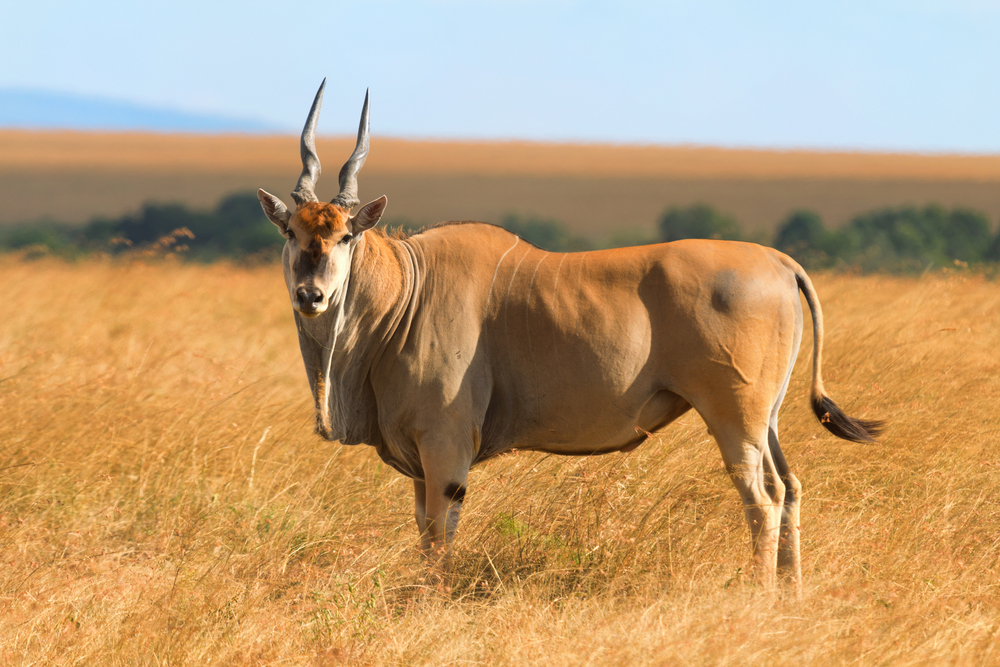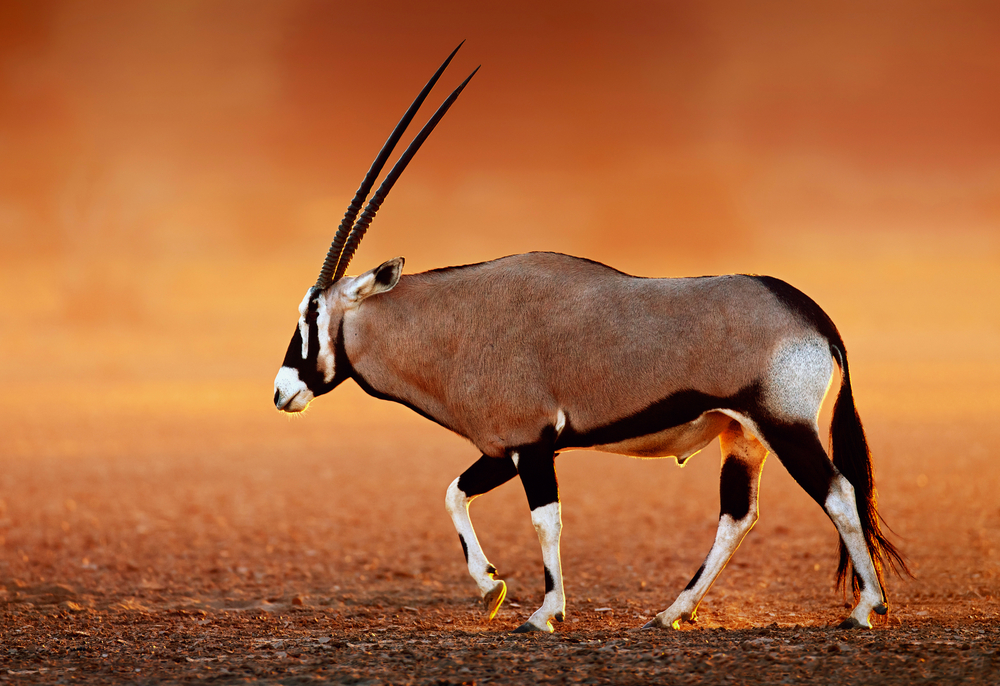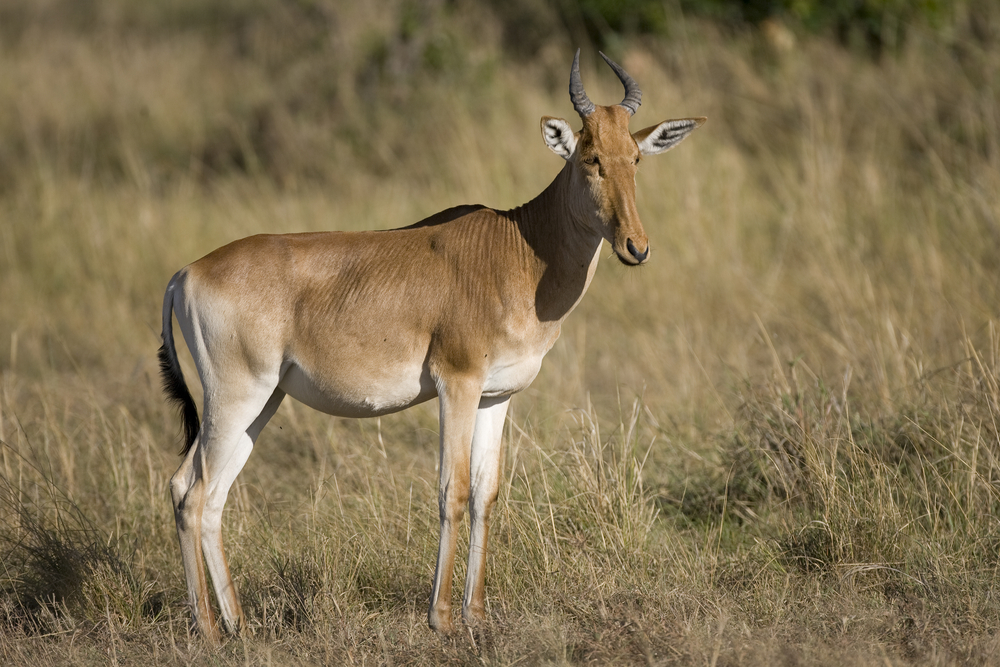About
The Hartebeest, scientifically known as Alcelaphus buselaphus, is an antelope species belonging to the Animal Kingdom’s phylum Chordata and class Mammalia. It is a member of the Bovidae family, which also includes other antelope species such as wildebeests and gazelles. Hartebeests are native to the grasslands and savannas of Africa, inhabiting regions from Senegal to Ethiopia and down to South Africa.
These antelopes are characterized by their distinctive appearance, featuring long, sloping backs, high shoulders, and elongated faces with narrow muzzles. They have slender legs and relatively small hooves adapted for swift movement across open terrain. Hartebeests typically have reddish-brown coats with lighter underbellies and prominent facial markings, including dark patches around the eyes and muzzle.
Hartebeests are primarily grazers, feeding on grasses and herbs found in their grassland habitats. They are often found in herds, which can range in size from a few individuals to several hundred. Their social structure may vary depending on environmental conditions, with some populations forming temporary associations or mixed-species groups with other herbivores.
Conservation Concerns
While Hartebeest populations are relatively stable across much of their range, they face localized threats from habitat loss, poaching, and competition with livestock for grazing resources. The International Union for Conservation of Nature (IUCN) Red List categorizes several subspecies of Hartebeest, such as the Western Hartebeest (Alcelaphus buselaphus major), as vulnerable due to declining populations.
Human activities such as agricultural expansion, urbanization, and hunting have contributed to habitat fragmentation and population declines in some areas. Conservation efforts aimed at protecting remaining grassland habitats, establishing wildlife corridors, and managing human-wildlife conflicts are essential for safeguarding Hartebeest populations and ensuring their long-term survival. Continued monitoring and conservation initiatives are crucial for maintaining healthy ecosystems where Hartebeests play a vital role as herbivores and prey species.
Physical Characteristics
Hartebeests are a group of antelope species, and their physical characteristics can vary somewhat depending on the specific species. Here is a general physical description of hartebeests:
Size:
- Height at Shoulder: Hartebeests typically stand around 4.3 to 5.3 feet (1.3 to 1.6 meters) tall at the shoulder.
Weight:
- Weight: Adult hartebeests generally weigh between 300 to 600 pounds (135 to 270 kg).
Physical Description:
- Body Shape: Hartebeests have a distinct body shape characterized by a relatively long face, sloping forehead, and a high-set, heavily ridged backbone. Their body appears somewhat horse-like.
- Coat Color: The coat color of hartebeests varies among species but is typically reddish-brown to tawny in color. Some species may have darker markings or patches on the face and legs.
- Horns: Hartebeests have unique, lyre-shaped, or “S”-shaped horns. The horn shape can vary among species, with some having more pronounced curves than others. Both males and females typically have horns.
- Facial Features: Their faces are marked with a dark mask or patches around the eyes and forehead, adding to their distinctive appearance.
- Legs: Hartebeests have long, slender legs adapted for running in open grasslands. These legs contribute to their agility and speed.
- Tail: They have a tufted tail with a black switch that can be seen flicking to deter insects or signal alarm.
It’s important to note that hartebeests encompass several species and subspecies, each with its own specific physical characteristics and range. While the general size and shape described above apply to many hartebeest species, there may be variations in coat color, horn shape, and other features depending on the specific region and species.
Reproduction
The reproductive cycle of hartebeests follows a pattern common to many antelope species. Here is an overview of the hartebeest’s reproductive cycle:
Mating and Courtship:
- Hartebeests are polygynous, which means that dominant males, known as bulls, establish territories and compete for access to groups of receptive females, known as cows.
- Mating behavior often involves courtship displays, vocalizations, and physical interactions among males to assert dominance and attract females.
- Mating can occur year-round, but there may be peak breeding seasons depending on environmental conditions and the specific hartebeest species.
Gestation:
- The gestation period for hartebeests typically lasts around 8 to 9 months, or approximately 240 to 270 days.
- After mating, it takes this duration for a female hartebeest to give birth to her offspring.
Birth:
- Hartebeest females usually give birth to a single calf, although the birth of twins can occur but is relatively rare. Calves are typically born with their eyes open and are capable of standing and walking shortly after birth.
- The mother provides care and protection to the calf, including nursing it with milk for an extended period. The calf remains dependent on its mother for nourishment and protection during its early stages of life.
Parental Care:
- Mother and calf maintain a close bond, and the calf relies on its mother’s milk for sustenance during its early months.
- As the calf grows, it gradually transitions to a herbivorous diet, learning from its mother and other group members how to forage for food in the grasslands or savannas.
Hartebeests, like many antelope species, have adapted their reproductive patterns and strategies to their specific environments and ecological niches. The birth of a single calf at a time allows the mother to invest significant care and attention to ensure the calf’s survival and growth in the often challenging conditions of the grasslands and open habitats they inhabit.
Lifespan
The lifespan of hartebeests, both in the wild and in captivity, can vary depending on various factors, including the specific species, environmental conditions, and threats they face. Here’s a general overview of the hartebeest’s lifespan and the major threats to their survival:
Wild Lifespan:
- In the wild, hartebeests typically have a lifespan ranging from 12 to 15 years, although some individuals may live longer under favorable conditions.
- Factors that can affect their lifespan in the wild include predation, habitat quality, competition for resources, and exposure to diseases.
- Predators like lions, cheetahs, leopards, and hyenas pose a significant threat to hartebeests, especially to calves and weakened individuals.
Lifespan in Captivity:
- Hartebeests in captivity can live longer lives compared to those in the wild, given they receive consistent access to food, veterinary care, and protection from predators.
- In captivity, hartebeests can live up to 20 years or more, depending on the quality of care provided.
Biggest Threats: Hartebeests face several threats to their survival in the wild:
- Habitat Loss: Habitat destruction due to human activities, such as agriculture, deforestation, and infrastructure development, has led to the loss of critical grassland habitats that hartebeests rely on for food and shelter.
- Hunting and Poaching: Hartebeests have been historically hunted for their meat and hides. Poaching, particularly for the bushmeat trade, continues to be a threat in some regions, as it puts additional pressure on hartebeest populations.
- Human-Wildlife Conflict: In areas where human populations encroach on hartebeest habitats, conflicts can arise over resources like grazing lands and water, leading to retaliatory killings or habitat degradation.
- Disease Outbreaks: Infectious diseases can impact hartebeest populations, especially when they occur in crowded or stressed conditions. Outbreaks of diseases such as anthrax or bovine tuberculosis can be devastating.
- Climate Change: Climate change can alter the availability of food and water resources for hartebeests, disrupt migration patterns, and increase the risk of extreme weather events that can negatively impact populations.
Conservation efforts, including the establishment of protected areas, habitat preservation, sustainable hunting practices, and initiatives to reduce human-wildlife conflicts, are crucial for mitigating these threats and ensuring the long-term survival of hartebeest populations. As important herbivores in their ecosystems, hartebeests play a role in shaping grassland habitats and supporting the diversity of wildlife that depends on these environments.
Eating Habits
Hartebeests are herbivorous mammals with specific eating habits adapted to their grassland and open savanna habitats. Here’s a description of their eating habits:
Diet:
- Hartebeests are predominantly grazers, meaning they primarily feed on grasses. Their diet consists mainly of various grass species found in their habitats.
Foraging Behavior:
- Hartebeests are often seen foraging in open grasslands and savannas, where they graze on a variety of grasses.
- They use their elongated and pointed muzzles, along with their tough, prehensile lips, to efficiently crop grass close to the ground. This feeding behavior allows them to access the freshest and most nutritious parts of the grasses.
Selective Feeding:
- Hartebeests are selective feeders and tend to choose the most nutritious and palatable grass species when available.
- They may preferentially target certain grasses based on their nutritional content and may adjust their diet in response to seasonal changes in grass availability and quality.
Water Dependency:
- Hartebeests are water-dependent herbivores, and they need regular access to freshwater sources for drinking. In regions with seasonal rains, they may migrate in search of water during dry periods.
Behavioral Adaptations:
- To optimize their foraging efficiency, hartebeests often form loose herds, which allows them to collectively monitor their surroundings for potential threats while grazing.
- They have evolved various behaviors, such as grazing in the early morning and late afternoon when temperatures are lower, to avoid the heat of the day.
Hartebeests’ ability to graze efficiently on grasses is essential to their survival in open habitats, where grasses are the primary food source. Their grazing habits also play a role in shaping the composition of grassland ecosystems and influencing the abundance and diversity of other wildlife species that depend on these grasses for food.
Uniqueness
Hartebeests possess several unique characteristics and adaptations that set them apart from other herbivores and make them remarkable animals in their own right:
- Distinctive Appearance: Hartebeests are easily recognizable due to their unique physical features, including a sloping forehead, elongated face, and lyre-shaped horns. Their high-set, heavily ridged backbone and long legs contribute to their distinct appearance.
- Singular Horns: The hartebeest’s horns are notably distinctive. They curve backward, forming an “S” or lyre shape, with a forward-facing hook at the tips. Both males and females typically have these lyre-shaped horns, setting them apart from many other antelope species with different horn shapes and sexes.
- Adapted for Grasslands: Hartebeests are specialized for life in open grasslands and savannas. Their elongated muzzles and prehensile lips are adapted for efficient grazing on grasses close to the ground.
- Water Dependency: Unlike some other herbivores, hartebeests are water-dependent. They need regular access to freshwater sources, and this dependence on water sources can influence their movement patterns and migrations.
- Unique Mating Behavior: Hartebeests exhibit polygynous mating behavior, where dominant males establish territories and compete for access to groups of receptive females. This social structure and mating behavior are distinct to hartebeests and contribute to their unique reproductive dynamics.
- Ecological Role: As grazers, hartebeests play a crucial role in shaping grassland ecosystems. Their foraging habits influence the composition of grass species, which, in turn, affects the abundance and diversity of other wildlife species that depend on these grasses for food.
- Conservation Significance: Hartebeests are not only important ecologically but also culturally and economically in the regions where they are found. They are hunted for their meat and hides and are often featured in local folklore and traditions.
- Savanna and Grassland Specialists: Hartebeests are well-adapted to life in open habitats, which sets them apart from other antelope species that may inhabit a wider range of environments. Their ecological niche as savanna and grassland specialists highlights their adaptability to these specific landscapes.
Hartebeests’ unique combination of physical traits, behavior, and ecological importance makes them an iconic and recognizable species in the African grasslands and savannas, contributing to the biodiversity and dynamics of these ecosystems.
Related Family Species
Sources
- Alden, Peter et al, National Audubon Society Field Guide to African Wildlife, New York, NY.
- Britannica, Hartebeest, https://www.britannica.com/animal/hartebeest, retrieved January 2024.
- Burnie, David & Wilson, Don, Animal, Smithsonian Institute, Washington DC.
- Clutton-Brock, Juliet and Wilson, Don, Mammals, Smithsonian Handbooks, New York, NY.
- Hickman et al, Integrated Principle of Zoology, McGraw Hill, Boston.
- Nolting, Mark, Africa’s Top Wildlife Countries, Global Travel Publishers, Inc., Ft. Laurderdale, FL.




















































































